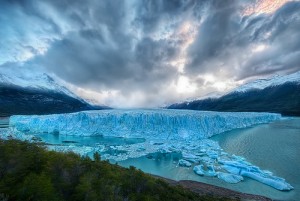Deciphering the big thaw
New York’s Long Island is built of earth plowed up thousands of years ago and shoved southward from Connecticut and other parts north. Like a bulldozer, a 500-meter-thick sheet of ice pushed its burden along, drew back and pushed again. The result is an island built of roughly parallel deposits of rock, gravel and sand called glacial moraines. Today, Long Island’s most evident moraines are the north and south forks, which provide its distinctive shape and real-estate allure.
All across the northern continents, glaciers piled up many more moraines, excavated lakes, scraped mountainsides and dropped boulders miles from their birthplaces. Their presence has been an accepted fact since at least the mid-19th century, but no one could say what caused the ice ages that brought the glaciers. Was it fluctuations in the sun’s energy? Were the sun’s warming rays sometimes filtered by passing clouds of interstellar dust? Did Earth’s own volcanic dust or magnetic field play roles?
In the 1930s, Milutin Milankovitch, a Serbian mathematician and engineer, suggested that sunlight variations were indeed the culprit, but not because of space dust or solar activity. Instead, changes in the planet’s movements varied the amount of sunlight, he said. Earth changes the angle of its tilt, like a nodding head. When its axis tends upward, the Northern Hemisphere is robbed of summer sun.
Also, since Earth wobbles as it spins, the seasons shift along the planet’s slightly elliptical orbit. Northern summer sometimes occurs at a point far from the sun.
Finally, Earth’s orbit oscillates. It sometimes is more elliptical than usual, carrying the planet even farther from the sun at some points.
Sometimes all three cycles coincide, plunging Earth into a particularly deep freeze.
The Milankovitch theory has held sway since 1976, when J.D. Hays, John Imbrie, and N.J. Shackleton showed there was a Milankovitch cycle at every major climate change over the past 500,000 years.
One major observation, however, remained to cast doubt on the idea: If increasing sunlight in the Northern Hemisphere triggered the end of the most recent ice age, why do clues to ice-age temperatures indicate the Southern Hemisphere warmed up before the Northern Hemisphere?
Now a team of researchers using Jaguar, a Cray XT supercomputer at Oak Ridge National Laboratory, has an answer. Simulations run over four years indicate changes in ocean currents gave the Southern Hemisphere a head start in warming up.
“Our results reconciled the Milankovitch theory and early Southern Hemisphere warming,” says Feng He, an assistant scientist at the Center for Climatic Research, Nelson Institute for Environmental Studies, at the University of Wisconsin–Madison.





